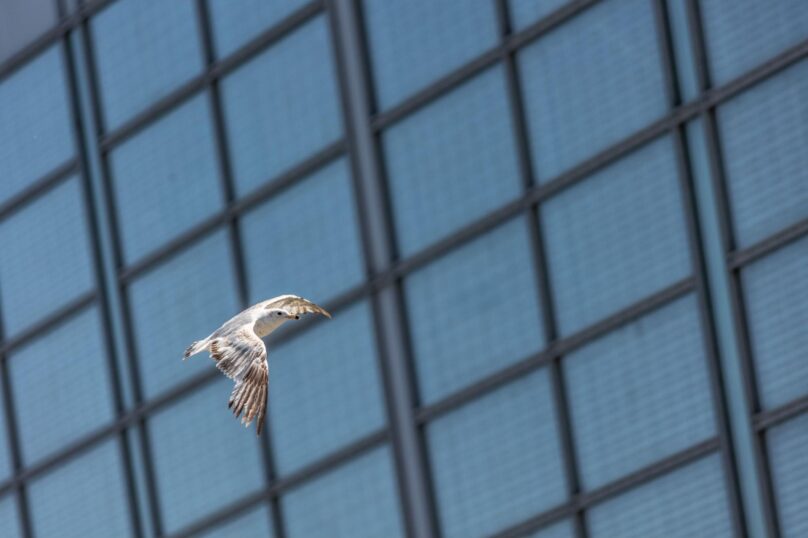
Birds may seem harmless but can cause serious trouble for commercial properties. Their droppings stain walls, ruin equipment, and create health risks. Nesting in signage, rooftops, and HVAC units can disrupt daily operations and damage infrastructure. Business owners dealing with persistent bird issues often waste time and money on short-term fixes. Property managers need reliable, long-lasting bird deterrents built for commercial environments.
Why Commercial Properties Attract Birds
Many commercial spaces offer birds precisely what they need to thrive. Tall buildings shelter them. Dumpsters and open food areas keep them fed. Rooftops and signage provide ideal places to nest. Once they settle in, they’re hard to remove.
Consistent Food and Water Sources
Birds stay where food is easy to find. Open dumpsters, loading docks, and outdoor dining areas draw them in. Leaky pipes, HVAC condensation, and puddles offer steady water sources. Once they know where to find food and drink, they keep returning. Removing these attractants is key to keeping them away.
Safe Nesting Opportunities
Flat rooftops, awnings, and ledges offer safe nesting spots. Birds look for hidden, undisturbed areas to build nests. Overhangs, signage, and vents become prime real estate. Once they nest, birds defend their space and multiply quickly. That’s when problems start to grow fast.
Minimal Disturbance
Most commercial properties are quiet at night. That gives birds a chance to nest and feed without human interference. Rooftops and high ledges are rarely checked or cleaned. Without disruption, birds grow comfortable and settle in. Regular inspections can help break that pattern.
Long-Term Impact of Bird Infestations
Bird problems aren’t just annoying—they’re costly. Droppings corrode surfaces and spread disease. Nesting birds clog vents, block drainage, and damage equipment. Over time, repairs add up, and safety issues grow. Ignoring bird infestations puts your property and reputation at risk.
Damage to Property and Equipment
Bird droppings are acidic and cause paint to peel and metal to rust. Nesting in HVAC units or electrical signs causes equipment failure. Rooftops and drainage systems clog from feathers and debris. Power outages or floods can follow. These issues demand expensive repairs.
Health and Safety Hazards
Bird waste carries bacteria, fungi, and parasites. Employees and customers can breathe these in or slip on droppings. Pigeons, starlings, and sparrows spread diseases like histoplasmosis and salmonella. Droppings left in high-traffic areas become a liability. Cleaning without proper PPE adds risk to maintenance staff.
Compliance and Legal Issues
Businesses must follow health and safety codes. Bird droppings in kitchens or warehouse areas violate regulations fast. Customers or employees injured by droppings can file lawsuits. Repeated citations may result in shutdowns or fines. Proactive prevention keeps you out of legal trouble.
Evaluating the Best Bird Deterrents for Commercial Properties
Choosing the proper bird deterrents depends on location, bird species, and property design. One-size-fits-all solutions rarely work for commercial buildings. Some deterrents work best in open areas, while others are suited to enclosed zones. Understanding your specific needs helps prevent wasted effort. The best bird deterrents use multiple strategies working together.
Physical Bird Deterrents for Business Use
Physical deterrents block birds from landing, roosting, or nesting. They work well on ledges, signs, rooftops, and other hard surfaces. These tools offer a clear message: birds aren’t welcome here. They last long, require little maintenance, and deliver strong results.
Bird Spikes
Bird spikes prevent birds from landing on flat surfaces. They come in metal or plastic and attach to ledges, beams, or railings. Spikes don’t harm birds but make landing uncomfortable. They work best for pigeons and seagulls in high-traffic nesting areas. Installers must cover the entire surface to avoid gaps.

Bird Netting
Bird netting creates a barrier birds can’t fly through. It works well for loading bays, signs, courtyards, and rooftops. The netting must be professionally installed to avoid sagging or tearing. It blocks birds completely without harming them. UV-resistant materials extend net lifespan outdoors.
Electric Track Systems
These tracks send a mild pulse when birds land. The shock isn’t harmful but scares birds off. They blend well with architecture and work on rooflines, sills, or signs. Installation should follow manufacturer specs to keep the voltage low and safe. Electric systems quickly deter repeat visits.
Visual Bird Deterrents for Commercial Settings
Visual deterrents scare birds using light, color, or movement. They confuse or frighten birds by mimicking predators or sudden changes. These methods are budget-friendly and easy to deploy. They work best with other tools, but birds often adapt if visual devices stand alone.
Reflective Devices
Birds dislike flashing lights and movement. Reflective tape, discs, or foil streamers bounce sunlight in unpredictable ways. These work best in open areas like rooftops or courtyards. Wind movement increases their effectiveness. Devices should be moved or replaced often for best results.
Predator Decoys
Plastic owls, falcons, or snakes trick birds into staying away. They work well at first but lose impact if left still. Regularly moving the decoys keeps birds guessing. Decoys with motion sensors or sound add realism. Use multiple types to avoid birds catching
Light-Based Systems
Strobe lights and laser deterrents confuse and scare birds. Lasers work best at dusk, dawn, or in shaded interiors. Strobe lights disrupt roosting at night or in dark areas. These are great for warehouses, hangars, or parking structures. Avoid overuse, or birds may grow used to them.
Auditory Bird Deterrents for Outdoor Areas
Auditory deterrents use noise to scare or confuse birds. Some mimic predator sounds or distress calls, while others emit ultrasonic waves that birds can hear but humans can’t. These are useful for large, open outdoor areas. Sound deterrents are most effective when sounds vary over time.
Ultrasonic Sound Emitters
These emit high-frequency sound waves that birds find irritating. Humans usually can’t hear them, so they’re discreet. They work best indoors or in enclosed loading docks. Effectiveness drops in open or windy spaces. Devices need regular maintenance and positioning checks.
Distress Call Devices
Birds react strongly to warning calls from their species. These devices broadcast those calls on a loop. They work well in parking lots, rooftops, and warehouse exteriors. Volume and timing should be adjusted to avoid noise complaints. Rotating the call pattern keeps birds from adapting.
Programmable Sound Systems
These systems rotate between predator, alarm, and distress sounds. Programmable setups help prevent birds from getting used to any one sound. They can be customized for bird type and area size. Timed broadcasts avoid constant noise exposure. These systems suit large commercial spaces.
Biological and Eco-Friendly Bird Deterrents
Some deterrents use nature or scent to shift bird behavior. They work subtly and are safe for sensitive environments. These are best used with other deterrents. Green solutions appeal to eco-conscious businesses. They can also help in areas where different tools aren’t allowed.
Falconry Services
Professional falconers use trained birds of prey to patrol your site. Their presence alone scares off pigeons, starlings, and gulls. Birds recognize predators and avoid the area long after the visit. Falconry is effective at large campuses, stadiums, and industrial parks. Scheduling must be consistent for long-term success.
Bird-Repelling Gels and Aromatics
Some gels irritate birds’ feet or emit scents birds avoid. These create uncomfortable landing zones without causing harm. Gels are clear and blend with building surfaces. Aromatics can be sprayed in tight, enclosed spots. Both need reapplication after heavy rain or cleaning.
Habitat Modification
Removing nests, sealing entry points, and cutting back trees greatly help. Birds won’t stay where they can’t shelter or feed. This step supports other deterrents by reducing temptations. Property audits can find hiding spots and vulnerabilities. Minor changes often make a significant difference.
Integrated Bird Deterrent Systems for Commercial Spaces
Combining different deterrents increases success. Birds are adaptable and will ignore a single approach over time. Integrated systems offer flexibility and cover more risk points. Experts often recommend layering visual, physical, and sound deterrents. Maintenance and monitoring are just as crucial as setup.
Combining Deterrents for Maximum Effectiveness
Using multiple deterrents keeps birds off balance. A rooftop might use spikes, sound devices, and reflective tape together. Loading docks could use netting, strobe lights, and gel. Blending strategies cover more surface area and bird types. Variety keeps birds from adjusting.
Custom Plans Based on Building Design
Every building has unique risk zones. A shopping center needs tools that are different from those in-house. Professionals assess bird behavior and property structure. They design a system that fits the layout, traffic, and local species. Custom plans reduce wasted effort and cost.
Professional Monitoring and Maintenance
No system runs perfectly without attention. Birds find weaknesses or return if equipment breaks. Regular checks fix wear, clogs, or tampering. Professional bird monitoring ensures that every deterrent still works. Minor repairs early prevent significant problems later.
Bird Deterrents That Protect Your Business
Birds don’t wait for permission to take over your property. They claim rooftops, ledges, and vents like unpaid tenants without leases. Left unchecked, their presence chips away at your reputation, safety, and bottom line. A passive approach only invites more problems. It’s time to shift from reacting to preventing—get ahead of the mess, the fines, and the constant cleanup. The proper bird deterrents aren’t just tools—they’re your property’s defense system. Start acting like the landlord and send the birds packing.
Want more ways to protect your property? Check out the Elite Bird Management blog for expert tips.





